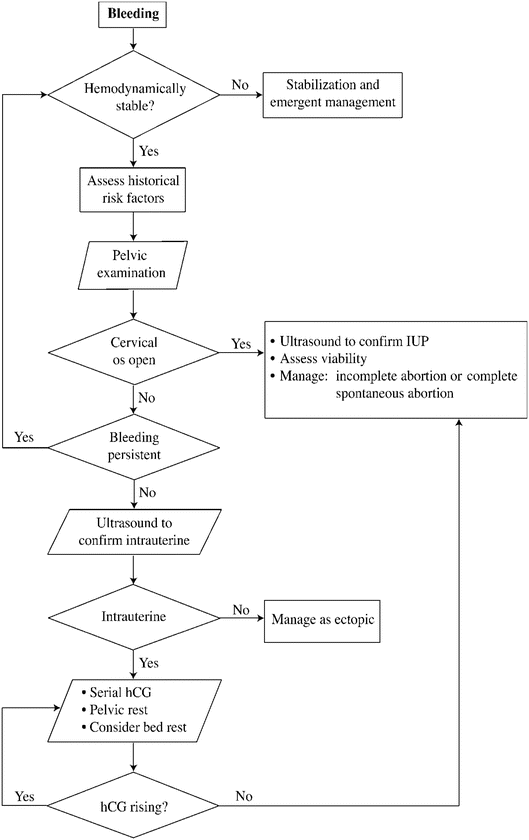(1)
Department of Family Medicine, University of California, Riverside, Riverside, CA, USA
Key Points
1.
Evaluation of early pregnancy bleeding should focus initially on identification of ectopic pregnancy and spontaneous abortion.
2.
The primary concern of initial management is assessment of hemodynamic stability and possible peritonitis.
3.
Management of ectopic pregnancy is designed to (a) minimize maternal morbidity and mortality, (b) remove the ectopic pregnancy, and (c) maximize potential future fertility.
4.
Management of possible spontaneous abortion begins with ruling out the possibility of ectopic pregnancy.
Background
Bleeding per vagina may occur at any point during the course of pregnancy and always warrants careful attention to identification and management of the underlying etiology. Bleeding that occurs late in pregnancy (generally within the third trimester) is covered in Chap. 10. Bleeding that occurs early in pregnancy (generally within the first trimester) is of particular concern because of concerns with pregnancy viability and possible ectopic pregnancy with its associated morbidity and mortality. A careful review of common etiologies combined with a careful history, directed physical examination, and selected diagnostic studies will allow the provider to identify the underlying cause and initiate appropriate management in a timely manner.
Early pregnancy bleeding per vagina is a relatively common presentation. Most cases of early bleeding are mild, self-limited, and of indeterminate etiology. Among the cases in which an etiology can be determined most are caused by either spontaneous abortion or ectopic pregnancy. Approximately 5–15 % of all pregnancies will end in a clinically recognized spontaneous abortion (involuntary expulsion prior to 20 weeks’ gestation). A considerably larger percentage (up to one-third) will end in an unrecognized abortion that is perceived to be menstrual bleeding. Although less common than spontaneous abortion, ectopic pregnancy is responsible for approximately 15 % of all maternal deaths. Although the differential diagnosis for early pregnancy bleeding includes several disparate conditions (see Table 9.1), the focus of initial evaluation is on identification of these two conditions. Less common causes of early pregnancy bleeding include trophoblastic disease and cervical pathology such as ulceration, infection, or cytopathology.
Table 9.1
Conditions associated with early pregnancy bleeding
Ectopic pregnancy |
Threatened abortion |
Incomplete abortion |
Complete abortion |
Trophoblastic disease |
Cervical polyps |
Cervical ulceration |
Cervical cytological abnormalities |
General Approach to Early Pregnancy Bleeding per Vagina
As noted, most cases of early pregnancy bleeding per vagina are of indeterminate cause. A significant minority are related to spontaneous abortion. A smaller but significant number are associated with ectopic pregnancy. Initial evaluation will be directed toward identification of patients with these two conditions, documentation of the viability of the pregnancy, assessment of the medical stability of the mother, and reassurance for patients without evidence of either condition. Figure 9.1 outlines a general approach to the evaluation and management of early pregnancy bleeding.


Fig. 9.1
Evaluation and management of early pregnancy bleeding
History
A careful history should be obtained of the bleeding itself as well as associated symptoms. In regard to the bleeding itself, information should be obtained concerning the following:
1.
Characteristics of the bleeding (e.g., is it scant or copious, bright red or brown, and clot-like?).
2.
Onset of the bleeding (e.g., did it start abruptly or gradually?).
3.
Duration of the bleeding (how long has the bleeding lasted?).
4.
Intensity of the bleeding (how much bleeding has been noticed? It may be helpful to use as comparison to normal menstrual flow, although providers should note that there is considerable physiological variability in the quantity of normal menstrual flow).
5.
Exacerbating factors (did anything appear to precipitate the bleeding or make the bleeding worse once it had started?).
6.
Relieving factors (has anything made the bleeding diminish or stop?).
Particular attention should be paid to trauma, activity (including sexual activity), and associated symptoms such as pain, dizziness, or weakness. The patient’s past history should be reviewed for risk factors such as smoking, multiple sexual partners, past history of pelvic inflammatory disease, or intrauterine device use. Prior gynecological surgery should be reviewed, including tubal ligation and uterine surgery (including myomectomy). Any prior diagnosis of anatomic abnormalities of the genital tract should be noted. The patient’s obstetrical history should be reviewed for prior ectopic pregnancies and/or spontaneous abortions. The prenatal course should be reviewed for any high-risk conditions that may have been previously noted, including a family history of significant genetic abnormalities or significant toxic or infectious exposures. A note should also be made of the patient’s gestational age and the means used to determine the estimated delivery date.
Stay updated, free articles. Join our Telegram channel

Full access? Get Clinical Tree


